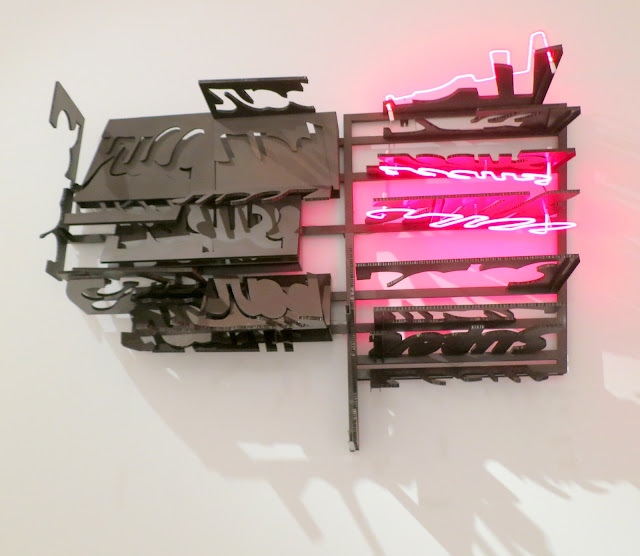
Documenta 14 at the National Museum of Contemporary Art, or EMST, in Athens.
I had to visit the National Museum of Contemporary Art twice in order to see the works of around 80 artists that have taken over the whole of this museum - having perused two floors during my first visit I was 'arted-out' and felt that if I stayed on I would not do the works justice.
It's a dense show both in terms of the sheer amount of art on display but also in terms of the many messages and meanings/philosophies it expounds. Lesser-known work by indigenous artists is at the forefront while big names are few and far between. The idea is to shake preconceptions amid the 'current sad and threatening state of official politics', the artistic director Adam Szymczyk has said. The show questions the physical forms in which value - economic, political, ethical - resides, and the extent to which these have been deformed by Western imperialism. Consequently, this exhibition is like no other I have ever seen, hence the need for two visits.
View of the ground floor exhibition room

Twenty two masks from the series Atlakin by Beau Dick.

Beau Dick, an artist and Hereditary Chief from a small Dzawada'enux villabe on Canada's northwest coast, passed away in March.

Beau Dick, Tsonoqua Mask

Beau Dick, Untitled, (copper ingot made from discontinued Canadian pennies, letter)
Beau Dick, Taw Copper, 2012, (copper)
On the role of copper in Kwakwaka'wakw society: 'Each tribe has its own coppers, and each copper has its own value. In the old days there was no money and these coppers were a standard of value but increased in value each time they changed hands. When the white man came and we could earn wages in cash for our labor, we invested our savings in coppers and used them the same as a white man would do with a bank and would always expect more back than we put in'. (from a letter written on behalf of Namgis First Nation on 16 April, 1919).


Sammy Baloji, Tales of the Copper Cross Garden: Episode I, (2017)
The video documents the process by which copper is drawn into wire from glowing, semi-liquid ingots. A choral mass provides the solemn soundtrack, while sporadic all-caps intertitles weave biographical details (the artist grew up in the mining region of Katanga in the Democratic Republic of Congo) with a reflection on the role of the Church in the colonial enterprise in Africa.

On a wall perpendicular to the screen, a large-scale blow-up print of a grainy black and white photograph depicts singing choirboys. Over their white robes, they wear large Katanga crosses; copper forms resembling the cross of St Andrew that, since at least the 13th century, were used in the mineral-rich region as a form of currency, as women's dowry and as talismans buried with the deceased.


Beau Dick, Raven masks, 2000
Don Patterman, Athens Ingot Project (Copper), 2017 (scavenged copper wire and cable, ship parts, ingot-casting table, foundry tools and metals commodity-pricing data)
Since the 1980s, the work of Chicago artist Dan Peterman has been determined by the convergence of economic and environmental concerns, leading to the development of a research-intensive practice of recycling as both ethos and expression, form and content.
For discarded materials to reenter the economy, they must be fashioned into standardised units or - ingots. Discovering the figure of the Ingot God in the Archaeological Museum of Athens, Peterman realised that the ancients also understood this concept. His work for Athens involves delving into the local history of bronze and copper manufacture as well as the current practice of recycling these metals.
The table was acquired from a scrap dealer operating near the Botanikos neighbourhood of Athens.
Chryssa, Cityscape Times Square, #2

Stephen Antonakos, White Cube with Blue and Red Neon, 1982

Vlassis Caniaris, Aspects of Racism II, 1970

As we leave EMST, we catch sight of Hans Haacke's rainbow-coloured banner hanging on one of the museums's exterior walls: 'We (all) are the people', it reads, in many languages.










No comments:
Post a Comment